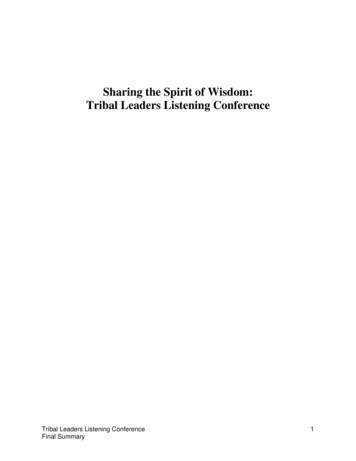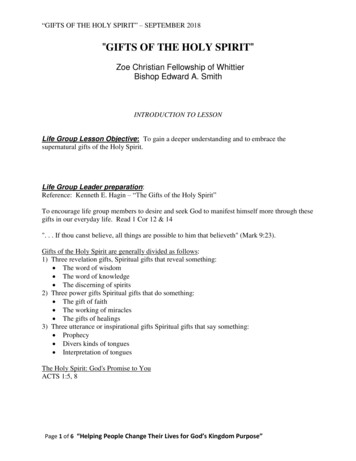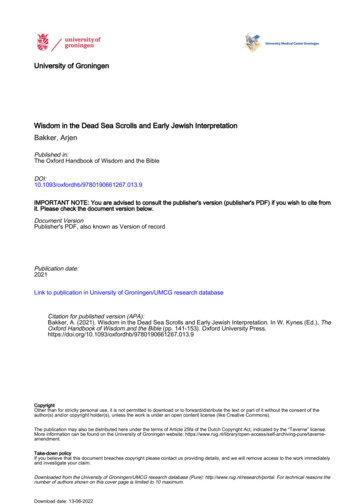
Transcription
Sharing the Spirit of Wisdom:Tribal Leaders Listening ConferenceTribal Leaders Listening ConferenceFinal Summary1
AcknowledgmentsThe Office of Juvenile Justice and Delinquency Prevention (OJJDP) wants to acknowledge theBureau of Indian Affairs (BIA) for its support and assistance throughout this entire ListeningConference process. Special thanks to Velma Mason, Division Chief, Division of Alcohol andSubstance Abuse Prevention; Sandie Johnson, Coordinator, BIA Regional Alcohol andSubstance Abuse Prevention Coordinators; Lynette Rojo, Pacific Regional Alcohol andSubstance Abuse Coordinator; and Walter Lamar, Director of Law Enforcement.OJJDP thanks the following agency representatives for their presentations of information,contributions of comments, and commitment of time and interest in addressing juvenile justiceconcerns for tribal communities: Tracy Toulou, Director, Office of Tribal Justice, U.S. Department of Justice (DOJ). Alex Escarcega, Juvenile Services Administrator, Bureau of Prisons, DOJ. Norena Henry, Director, American Indian and Alaska Native Affairs Desk, CommunityCapacity Development Office, Office of Justice Programs (OJP), DOJ. Nelson Hernandez, Director, Community Capacity Development Office, OJP. Thomas Heffelfinger, U.S. Attorney, Executive Office of the U.S. Attorneys (EOUSA),District of Minnesota, and Chair of the Attorney General Advisory Committee’s NativeAmerican Issues Subcommittee. Steven Perry, Statistician, Bureau of Justice Statistics, OJP. Terry Coli, Executive Director, Public Relations and Deputy Head, Canadian Embassy. Bruce Bernstein, Assistant Director for Cultural Resources, National Museum of theAmerican Indian.Tribal Leaders Listening ConferenceFinal Summary2
Tribal leaders involved for their commitment and dedication:Alaska RegionMidwest RegionZenia BoreninCouncil MemberAkutan Traditional CouncilAkutan, AKTonia TeepleYouth Substance Abuse CounselorBay Mills Substance Abuse ServicesBrimley, MILisa Jaeger, M.A.Tribal Government SpecialistTanana Chiefs ConferenceFairbanks, AKNavajo RegionEastern RegionGilbert Billy BlueChiefCatawba Indian NationRock Hill, SCWilliam PhillipsChiefAroostook Band of MicmacsPresque Isle, MEEastern Oklahoma RegionTarpie YargeeChiefAlabama-Quassarte Tribal TownTribal Coordinating CommitteeWetumka, OKRichard ShowalterSenior Contract AnalystDepartment of Behavioral Health ServicesNavajo NationWindow Rock, AZNorthwest RegionRodney R. Clarke, J.D.Chief Executive OfficerKlamath Tribes Alcohol and Drug AbuseProgramKlamath Falls, ORLeo StewartVice ChairmanConfederated Tribes of the UmatillaIndian ReservationPendleton, ORGreat Plains RegionDavis E. WashinesTribal Council SecretaryYakama NationToppenish, WAPatricia Broken Leg-BrillFacility AdministratorRosebud Sioux Tribe Wanbli WiconiRosebud, SDSheri-Lee WilliamsSecretaryLummi Nation Tribal CouncilBellingham, WADuane SilkStanding Rock Sioux TribeFort Yates, NDTribal Leaders Listening ConferenceFinal Summary3
Pacific RegionAngelina ArroyoICWA Director and Youth CounselorHabematolel Pomo of Upper LakeUpper Lake, CAMargaret E. GarciaDivision DirectorDivision of Health ServicesPueblo of ZuniZuni, NMEdward Guyer IITribal CouncilmanHoopa Valley TribeHoopa, CASheriff Carl A. TsosieTribal Councilman and HousingCommissionerPicuris PuebloPenasco, NMRocky Mountain RegionWestern RegionAbraham B. ChopperCouncilmanTribal Coordinating CommitteeFort Peck Tribal CouncilPoplar, MTMichelle S. BegayLieutenantLaw EnforcementTohono O’odham NationSells, AZDonna L. TrosperProject DirectorWind River Tribal Youth ProgramEastern Shoshone TribeFort Washakie, WYSandra HicksDirectorStepping Stones Tribal Youth ShelterFallon TribeFallon, NVSouthern PlainsKaren J. HonanieSubstance Abuse CounselorHopi Guidance CenterBehavioral Health ServicesSecond Mesa, AZDara K. Komahcheet, M.S.Director of Behavioral HealthAbsentee Shawnee Tribe of OklahomaShawnee, OKSouthwest RegionRobert ComerDirectorBehavioral Services CenterLaguna Service CenterLaguna PuebloLaguna, NMTribal Leaders Listening ConferenceFinal SummaryTribal ObserverLiz SalwayJuvenile Probation OfficerWind River Tribal Youth ProgramEastern Shoshone TribeFort Washakie, WY4
ContentsAcknowledgmentsExecutive SummaryIntroductionBackgroundJuvenile Delinquency in Indian CountryTribal Leaders Listening Conference, Washington, DC: SummaryReferencesAppendix A. Summary of Focus GroupsAppendix B. OJJDP and Tribal Leaders Listening Conference Meeting Agenda andParticipant ListTribal Leaders Listening ConferenceFinal Summary5
Executive SummaryAlthough violent crime rates in tribal communities are two to three times higher than the nationalaverage, the communities have been unable to address the causes due to a long history of a lackof resources. In addition to crime, violence, and the fear of victimization, insufficient educationalresources, inadequate access to appropriate health care, and overwhelming rates of alcohol andsubstance abuse threaten the safety and future of Indian families and children.To address these concerns, the Office of Juvenile Justice and Delinquency Prevention (OJJDP)convened a Tribal Leaders Listening Conference September 27–28, 2004, in Washington, DC, tofoster collaboration between tribes and the federal government on issues and challenges affectingtribal youth. Tribal leaders from 12 regions and representatives from OJJDP, other U.S.Department of Justice offices, and the U.S. Departments of the Interior and Health and HumanServices participated.During the summer, conference participants had gathered at regional focus groups in SanFrancisco, CA (June 22–23), and Green Bay, WI (August 30–September 1). These sessionsserved to initiate discussions and shape the content of the final conference.Conference presentations and discussions addressed the following topics: Historical overview and government-to-government relations. Juvenile justice: Courts, jurisdiction, law enforcement, and detention facilities.Tribal Leaders Listening ConferenceFinal Summary6
Health care: Access to services, addressing domestic violence and child abuse. Prevention/intervention/treatment: Alcohol/drugs, mental health, and spirituality. Education: No Child Left Behind, national curriculum for Indian law and Indian history. Resources: Regionalization, Alaska considerations, and grant funding. Technical assistance: Geographic and technological challenges.A full summary of conference discussion of each topic and the recommendations that came outof these discussions is included in the report. Sample recommendations from the conferencefollow. Both native people and those who work in and around Indian country must focus on movingbeyond the past. Training for states on tribal issues could be federally mandated, with a penalty for notcomplying. Promote accountability. Native people need to be committed to wanting to change theircurrent quality of life. Emphasize prevention. The current emphasis on remediation should be replaced by anemphasis on prevention strategies for youth and parents alike.Tribal Leaders Listening ConferenceFinal Summary7
For effective prevention, intervention, and treatment programs to be sustainable, tribes mustrelearn the Indian cultural structure, which should include keeping tribal members within thecommunity for treatment and rehabilitation. Tribes in the planning stages of developing new programming efforts need resources andreference materials on both effective, culturally competent programs and service providersand tested strategies and best practices. Spirituality should be a vital part of treatment, prevention, and intervention strategies. When developing parenting and community interventions, include education about traditionalnative values and practices and respite and support for both parents and children. Involve representatives from tribal communities in the development of requests forproposals. Lengthen grant funding cycles and include continuation opportunities for tribes that candemonstrate successful progress in program development. Many tribes are unable to fullysustain programs after grants end, resulting in frequent termination of viable programs. Provide the technological resources required for the grant application and reporting processto the tribes that need these resources and/or provide for alternate methods of applying andreporting. Tribal representatives should be included in the process of identifying priorities for Indiancountry, including the development of a potential series of pilot programs. The criteria for what constitutes Indian country in terms of qualification for funding shouldbe redefined, as the current criteria are ineffective.Tribal Leaders Listening ConferenceFinal Summary8
While the discussion and recommendations from the conference are a promising beginning,successful partnership between the Department of Justice and the tribes will require a long-termstrategy that is developed collaboratively. Robert Flores, OJJDP Administrator, suggested theneed to identify common themes. Three themes are key. First, no one knows tribal communitiesbetter than tribal leaders. Second, if possible, all areas of the justice system should plancollaboratively with regard to Indian country. Finally, protecting culture means understandingwhat is needed to strengthen families and should look beyond the influences that are affectingthe tribes’ ability to maintain local culture and traditions.Tribal Leaders Listening ConferenceFinal Summary9
IntroductionTo fulfill its policy on Indian sovereignty and government-to-government relations with Indiantribes, the U.S. Department of Justice (DOJ) endeavors to forge strong partnerships with Indiantribal governments. The following six principles guide Department interactions with the Indiantribes: Recognition of the sovereignty of Indian tribes. Commitment to operate on the basis of government-to-government relations with Indiantribes. Commitment to strengthen and assist Indian tribal governments in their development and topromote tribal self-governance and self-determination. Commitment to be guided by the federal trust responsibility arising from the United States’legal and historical relationship with the Indian tribes. Commitment to safeguard the civil rights of American Indians. Commitment to respect and protect tribal religion and culture.President Bush and former Attorney General John Ashcroft have cited these principles, and J.Robert Flores, Administrator of the Office of Juvenile Justice and Delinquency Prevention(OJJDP), a bureau of DOJ’s Office of Justice Programs, invoked them in June 2004 when heextended an invitation to tribal leaders to participate in a Tribal Leaders Listening Conference inWashington, DC, September 27–28, 2004, and two regional focus groups prior to the conference.The purpose of the focus groups, which took place in San Francisco, CA, and Green Bay, WI,was to initiate discussion about issues of concern to those who work with tribal youth andthereby shape the content of the final Listening Conference.Tribal Leaders Listening ConferenceFinal Summary10
This report presents the compilation of both focus groups and a summary of the ListeningConference proceedings. The report also includes background information on OJJDP and theOffice’s Tribal Youth Program, the planning of the Listening Conference, and the state ofjuvenile delinquency in Indian country. A participant list is provided in appendix B.Tribal Leaders Listening ConferenceFinal Summary11
Tribal Youth ProgramEstablished by Congress in 1999, the Tribal Youth Program (TYP) is part of the Indian countryLaw Enforcement Initiative, a joint initiative of the U.S. Departments of Justice and the Interior toimprove law enforcement and juvenile justice in Indian country. TYP supports and enhances tribalefforts to prevent and control delinquency, improve the juvenile justice system, and support mentalhealth and substance abuse services for American Indian and Alaska Native youth.TYP promotes safe communities in Indian country by funding projects and activities to help thetribes: Reduce, control, and prevent juvenile delinquency. Develop interventions for court-involved youth. Improve tribal juvenile justice systems. Develop programs to prevent alcohol and substance abuse among youth. Develop comprehensive mental health services.TYP respects tribal sovereignty by engaging the community in a comprehensive planning processto develop responses that preserve tribal customs and traditions. The planning process isanalogous to a journey in that it takes the tribe through the steps of identifying where they arenow, where they want to go, and how they will get there. The planning process also includesidentifying benchmarks that will assist the tribe in recognizing when they have achieved theirgoals.Currently, 239 federally recognized tribes receive funding through TYP. These funds supportinitiatives such as mentoring programs, equestrian programs, treatment beds at the Healing Lodgeof the Seven Nations in Oregon, and Boys & Girls Clubs throughout Indian country. The programserves not only youth, but communities. Mentoring traditional and spiritual ways cannot bemeasured by job descriptions.OJJDP Administrator J. Robert Flores visited TYP sites in Arizona and Utah in 2003 as part of an8-day tour of Indian country. Shortly after this tour, Mr. Flores again visited Indian country toprovide welcoming remarks at the Window Rock, AZ, conference, Holding Up Both Ends of theSky: Juvenile Justice Partners in Indian Country. This conference hosted the first nationwide tribalvideoconference from Indian country. The 2-hour program was broadcast live in 32 states and1could be viewed online through streaming video.——————————1The video of the teleconference “Holding Up Both Ends of the Sky: Juvenile Justice Partners in IndianCountry” can be viewed at the Juvenile Justice Teleconferencing tml/.Tribal Leaders Listening ConferenceFinal Summary12
BackgroundThe Office of Juvenile Justice and Delinquency Prevention provides national leadership,coordination, and resources to prevent and respond to juvenile delinquency and victimization. Itsmandate encompasses the promotion of programming to prevent, reduce, and control juveniledelinquency in Indian country. The Tribal Leaders Listening Conference was undertaken infulfillment of this mandate. The objective of the Listening Conference and the focus groups thatpreceded it was to bring tribal representatives together for the following purposes: Identifying youth issues deemed important within their regions. Prioritizing those issues. Discussing the role of government in effectively addressing the prioritized issues. Presenting their findings in an open forum conducive to discussions between these leadersand representatives of the federal government at the policymaking level.Identifying Tribal LeadersOJJDP invited 36 tribal leaders, representing the 12 regions of Indian country. These regionswere identified by using the Bureau of Indian Affairs (BIA) process for consulting andcommunicating with Indian country. Distribution by region is shown in the following table.Tribal Leaders Listening ConferenceFinal Summary13
Tribal Representatives Participating in the Listening ConferenceRegionStatesNumber ofRepresentativesAlaskaAlaska3Navajo NationArizona1SouthwestColorado and New Mexico3WesternArizona, Nevada, and Utah3PacificCalifornia3Eastern TribesAlabama, Connecticut, Florida, Louisiana, Maine,Mississippi, New York, North Carolina, andRhode Island4NorthwestIdaho, Montana (Flathead, Kootenai, Salish), Oregon, andWashington4Rocky MountainMontana, Wyoming3Great PlainsNebraska, North Dakota, and South Dakota3MidwestMichigan, Minnesota, and Wisconsin3Eastern OklahomaEastern Oklahoma tribes3Southern PlainsKansas, western Oklahoma, and Texas3The use of elders and traditional practitioners as resources and adherence to certain basic socialprotocols proved critical to the success of the focus groups. Drawing upon the elders presenthelped demonstrate the seriousness of the Listening Conference and recognized, respectfully, theelders’ place in native culture. The elders had the opportunity to express their traditionalpractices, which represents their role in native society, namely to give spiritual guidance inmatters of culture and tradition and thereby promote community development. In every sessionparticipants followed traditional protocols, such as the offering of tobacco and use of prayer toopen and close the meetings.Tribal Leaders Listening ConferenceFinal Summary14
Juvenile Delinquency in Indian CountryCrime has declined throughout the United States, except in Indian country, where statisticsindicate that the incidence of crime by and against American Indians, particularly juveniles, farsurpasses that of ethnic groups in other areas. The crime rate for American Indians and AlaskaNatives is 656 incidents per 100,000 citizens—150 incidents more per 100,000 citizens than therate for the general U.S. population (Hickman, 2003).Although violent crime rates in tribal communities are two to three times higher than the nationalaverage (Wakeling et al., 2001), these communities have been unable to address the causes dueto a long history of a lack of resources. In addition to crime, violence, and the fear ofvictimization, insufficient educational resources, inadequate access to appropriate health care,and overwhelming rates of alcohol and substance abuse threaten the safety and future of Indianfamilies and children.The data compiled below document the severity of the issues confronting Indian country.Alcohol and Substance AbuseA recent bulletin from the National Survey on Drug Use and Health (NSDUH), Risk andProtective Factors for Substance Use among American Indian or Alaska Native Youths (Officeof Applied Studies, 2004), reported that rates of cigarette smoking, binge drinking, and illicitdrug use among youth ages 12–17 were higher for the American Indian/Alaska Native (AI/AN)population than for other racial/ethnic groups. The same bulletin also indicated that risk factorsTribal Leaders Listening ConferenceFinal Summary15
for alcohol and substance abuse were higher among AI/AN youth than among youth of otherraces, as shown in the following tables.Youth Who Perceived Moderate to No Risk From Risk Factor ActivityPercentage of Youth Ages 12–17*American Indian/Alaska NativeOther Racial/Ethnic GroupsSmoking 1 or more packs of cigarettes per day46.736.3Having 4–5 alcoholic drinks once or twice per week67.861.6Activity* Estimates based on combined 2002 and 2003 NSDUH data.Parents Who Do Not Strongly Disapprove of Risk Factor ActivityPercentage of Parents*American Indian/Alaska NativeOther Racial/Ethnic GroupsSmoking 1 or more packs of cigarettes per day17.910.3Having 1–2 alcoholic drinks nearly every day15.211.2Activity of Youth Ages 12–17* Estimates based on combined 2002 and 2003 NSDUH data.Protective Factors for American Indian/Alaska Native Youth as Compared With Youth ofOther Racial or Ethnic GroupsPercentage of Youth Ages 12–17*American Indian/Alaska NativeOther Racial/Ethnic GroupsParticipation in youth activities73.885.7Attending religious services 25 times or more duringthe past year18.433.0Protective FactorIndividualFamilyTribal Leaders Listening ConferenceFinal Summary16
Parents discussed dangers of substance use withyouth54.858.5* Estimates based on combined 2002 and 2003 NSDUH data.The 2003 National Survey on Drug Use and Health showed that the AI/AN population has thehighest rate of lifetime illicit drug use, at 62.4 percent. Of the AI/AN respondents surveyed, 12.1percent reported current drug use (Office of National Drug Control Policy, 2004). In addition,more AI/AN youth than other youth believe that the majority of their peers use alcohol,marijuana, and cigarettes. Twenty-five percent of AI/AN youth believe all or most of their peersget drunk at least once a week, as compared with only 19 percent of other racial/ethnic groups.Youth Gangs in Indian CountryIn 2001, the National Youth Gang Center surveyed Indian communities across the United Statesabout gang activity. Of the 577 tribal leaders who received the survey, 300 (52 percent)completed and returned it (Major et al., 2004). Twenty-three percent of the respondents reportedhaving active youth gangs in their communities during 2000. The study results suggest thatlarger Indian country communities are more likely to experience gang activity, with thefollowing factors contributing to gang development: poverty, substance abuse, familydysfunction, the development of cluster housing, and a decreased connection to traditionalculture and in the traditional ties to cousins. Nearly 75 percent of all reported gang memberswere younger than 18 years of age. Criminal activity by gang members most often involvedgraffiti, vandalism, and drug sales. A review of the survey findings suggests that the socialproblems contributing to gang involvement, rather than the gangs themselves, are the mostcritical concern.Tribal Leaders Listening ConferenceFinal Summary17
Tribal Youth in PrisonThe increasing number of American Indian youth in Federal Bureau of Prisons (BOP) custody isof particular concern to American Indian tribes and DOJ. The confinement rate for AmericanIndian youth is disproportionate in 26 states. Between 29 and 42 percent of youth in secureconfinement in Alaska, Montana, North Dakota, and South Dakota are AI/AN. Between 1994and 2001, the Federal Bureau of Prisons system experienced a 50-percent increase in the numberof incarcerated AI/AN youth. By mid-2000, 16 percent of inmates in custody in Indian countryfacilities were juveniles (Building Blocks for Youth fact sheet).EducationAccording to the National Center for Education Statistics, the dropout rate of AI/AN students istwice the national average and the highest of any racial or ethnic group in the United States.Approximately 3 of every 10 AI/AN students drop out of school before graduating from highschool, both on reservations and in cities. In many areas, both on and off reservations, AI/AN dropout rates have reached epidemicproportions, e.g., 67 percent in Gering, NE, 81 percent in Winner, SD, and 71 percent inBlack River Falls, WI. For many AI/AN youth, achieving academic success while maintaining strong cultural ties—that is, learning to walk their native, culturally strong path on practical feet—continues to bea daunting challenge. Nine percent of AI/AN youth surveyed reported an average grade of D or lower for the pastsemester, compared to 6 percent for other racial/ethnic groups.Tribal Leaders Listening ConferenceFinal Summary18
Employment OpportunitiesUnemployment, which is often associated with crime and substance abuse, is a severe problem inIndian communities, reaching levels as high as 85 percent on some reservations. Nearly one-third(31.6 percent) of Indian people live below the poverty level, compared with 13.1 percent of thegeneral population (Coalition for Juvenile Justice, 2000).Mental HealthSuicide is the second leading cause of death for AI/AN youth between the ages of 15 and 24; thesuicide rate for these youth is 37.5 per 100,000—nearly three times the national rate of 13.2 per100,000 (Coalition for Juvenile Justice, 2000). A 2001 BIA study reported that 19 percent ofAI/AN high school youth had seriously considered suicide during the preceding year (Office ofIndian Education Programs, 2001).During a 12-week period from November 2004 to February 2005, eight young Native Americanadults committed suicide in separate events on the Standing Rock Sioux Reservation in NorthDakota and South Dakota. A few weeks later, 300 miles away on the Red Lake Reservation inMinnesota, a 17-year-old boy killed his grandfather and grandfather’s partner in the familyhome. He then went to school and took the lives of two adults and five classmates. Then hekilled himself (Walker, 2005).Of youth ages 7–17 who committed suicide between 1981 and 1998, 17,954 were white (86percent), 1,958 were black (9 percent), 443 were American Indian (2 percent), and 415 wereAsian (2 percent). Because white youth were 80 percent of the juvenile population during thisTribal Leaders Listening ConferenceFinal Summary19
period, they were overrepresented in juvenile suicides. More specifically, the suicide rate forwhite juveniles (31 per 1 million) averaged nearly twice the rates for black juveniles and Asianjuveniles (both at 18 per 1 million). However, the suicide rate for American Indian juveniles (57per 1 million) was almost twice the rate for white juveniles (Snyder and Swahn, 2004).Tribal Leaders Listening ConferenceFinal Summary20
Tribal Leaders Listening Conference, Washington, DC:SummaryThe Tribal Leaders Listening Conference was held in Washington, DC, on September 27–28,2004, to identify and address the multitude of issues affecting native youth. Representatives ofthe following federal agencies attended the conference: the Office of Juvenile Justice andDelinquency Prevention, OJP; the Office of Tribal Justice, DOJ; the American Indian and AlaskaNative Affairs Desk, Community Capacity Development Office, Office of Justice Programs,DOJ; the Community Capacity Development Office; the Bureau of Justice Statistics, OJP; theBureau of Prisons; the Division of Alcohol and Substance Abuse Prevention, Bureau of IndianAffairs; the Office of Law Enforcement Services, BIA; and the U.S. Attorney for Minnesota.Overview of Conference ProceedingsOpening CeremonyThe conference opened with a procession of tribal leaders into the Great Hall of the Robert F.Kennedy Building. Davis E. Washines of the Yakama Nation in Washington State sang thehonor and memorial songs for the procession. Mr. Washines was traditionally dressed andaccompanied himself with his tribe’s traditional bells. After the procession, Karen Honanie ofthe Hopi Tribe in Arizona offered words of welcome and prayer and performed a cedar and sageblessing of all meeting participants. She stated, “No one can bring change to this world bythemselves, so let’s all put our hearts and minds together to make a good life for our children.”This opening ceremony set the tone for the conference.Tribal Leaders Listening ConferenceFinal Summary21
Next, Tracy Toulou, Director of the Office of Tribal Justice, U.S. Department of Justice,introduced the conference participants. In his welcoming remarks, Mr. Toulou asked that theGreat Hall be filled with the voices of all participants.Welcome and IntroductionJ. Robert Flores, OJJDP Administrator, extended greetings from the President, the AttorneyGeneral, and the Deputy Director of the Office of Justice Programs. Stating that we have aresponsibility to ensure that every citizen receives equal justice, regardless of where he or shecomes from or lives, Mr. Flores affirmed that he was honored in the service of the Americanpeople to participate in the task of securing justice for youth.Citing issues that have risen to the forefront of the nation’s consciousness—crime, juveniledelinquency, education, health care, substance abuse, and keeping children safe from predators—Mr. Flores acknowledged that tribal communities face daunting challenges and that relationshipsbetween the federal government and the tribes need to improve. In particular, the governmentmust find ways to improve services and to bring resources to Indian country to address theissues, concerns, and challenges raised by tribal leaders.Referring to the conference’s theme, “sharing the spirit of wisdom,” Mr. Flores invoked thewords of Chief Sitting Bull, “Let us put our minds together and see what kind of life we canmake for our children.” These words, said Mr. Flores, should guide the participants’ discussionsof programs and policies to create a world where all Indian children will not simply survive, buthave the opportunity to live up to their fullest potential and take their rightful place asTribal Leaders Listening ConferenceFinal Summary22
contributing members of our communities and our society. This, he said, was the ListeningConference’s mission, in which our children need us to succeed.Conference BackgroundLaura Ansera, Program Manager for OJJDP’s Tribal Youth Program, next provided informationon the origins of the conference and led the way into the tribal leaders’ portion of the agenda.Ms. Ansera thanked Velma Mason, Division Chief, Alcohol and Substance Abuse Prevention,Bureau of Indian Affairs, and the Bureau for their assistance in contacting the 12 BIA regionaloffices and identifying tribal leaders to participate in the three events. The Bureau of IndianAffairs, Ms. Ansera said, was instrumental in identifying and bringing together a balanced crossrepresentation of the nations.Presentations by Tribal LeadersThe agenda on day 1 included presentations on the topics identified by the San Francisco andGreen Bay focus groups in preparation for the Listening Conference: Historical overview and government-to-government relations. Juvenile justice: Courts, jurisdiction, law enforcement, and detention facilities. Health care: Access to services, addressing domestic violence and child abuse. Prevention/intervention/treatment: Alcohol/drugs, mental health, and spirituality. Education: No Child Left Behind, national curriculum for Indian law and Indian history. Resources: Regionalization, Alaska considerations, and grant funding. Technical assistance: Geographic and technological challenges.Tribal Leaders Listening ConferenceFinal Summary23
A summary of recommendations and a question and answer session followed these presentations.The conference discussion of each topic and the recommendations that came out of thesediscussions are presented below under “Listening Conference Discussion by Topic.” Thecomplete conference agenda is included in the appendix.Additional Presentatio
Abraham B. Chopper . Michelle S. Begay . Councilman . Lieutenant Tribal Coordinating Committee Law Enforcement . Fort Peck Tribal Council . Tohono O'odham Nation . Poplar, MT . Sells, AZ . Donna L. Trosper . Sandra Hicks . Project Director . Director Wind River Tribal Youth Program Stepping Stones Tribal Youth Shelter . Eastern Shoshone Tribe .











